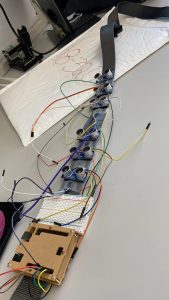For this week, our team has been focused on making sure that the core algorithm ran in the raspberry pi would function as expected and correctly evaluate incoming risks. We are mainly focused on processing the information from the depth camera. For more detailed information on this, check Kelton’s blog.
The other aspect is the information from the ultrasonic sensors. We tested out our machine in a regular lab environment, to see how well it would respond. So far the stats from the ultrasonic sensors seem quite stable. We did not make much change to the core algorithm behind processing the sensor data, only a few minor bug fixes here and there. Overall, the prototype belt has met our minimal expectancy in a select settings. We have yet to fully test out its functionality, which we hope to focus more on next week.
For the physical belt assembly, we are currently waiting on new materials such as foam casing for the ultrasonic sensors, shorter female jumpers for rerouting the circuits, and tape covering for exposed wires. We will finalize our assembly next week.
In our final week before the presentation, we would rebuild the physical belt one last time to make sure there are no component failures and everything is well organized. Then we would test out our belt and make any minor adjustments as needed. We will also add a new feature to visualize our belt’s functionality so we can better display our product. Our team has agreed to finish up other dues over the weekend so we can focus on testing throughout next week and especially over the weekends. So far we are expected to meet our goals before the presentation.



